
Official Edgar Rice Burroughs Tribute and Weekly Webzine Site Since 1996 ~ Over 15,000 Web Pages in Archive Volume 3037 HOW TO GET TO PELLUCIDAR II (concluded from Part I: ERBzine 3036) By Rick Johnson |

Official Edgar Rice Burroughs Tribute and Weekly Webzine Site Since 1996 ~ Over 15,000 Web Pages in Archive Volume 3037 HOW TO GET TO PELLUCIDAR II (concluded from Part I: ERBzine 3036) By Rick Johnson |
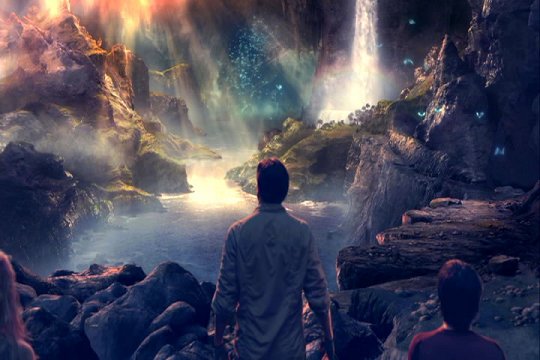
There is a complementary Opening at the South Pole (offset as in the North), however, unlike the Northern Opening which is often open (though as often closed by ice in the Northern Winter), the Southern Opening is always buried under a mile of ice!
THE SOUTH POLAR OPENINGDespite this, there appears to be a Mega-Cavern under that ice sheet, referred to as The Savage Land. This Mega-Cavern is connected to Pellucidar but the opening to the Antarctic surface is small and almost always sealed by ice, save during the warmest of the Antarctic Summers. The Migration Route into Pellucidar being undiscovered by any visitor who, like those who visited any of the Lost Lands, believes The Savage Land to be isolated and a Dinosaurian Survival and so explored no further.
Despite this, over the years, may visitors have managed to enter the Savage Land, some like Shanna and Ka-Zar, remaining. It is equally interesting to note that over the years many rumors have surfaced about this Land, the most common being that it was created by an alien race.
What is more likely is that The Savage Land is a natural Migration Terminus of Pellucidar, touching the South Polar Opening, that has been used by Aliens and Humans alike, each inventing their own stories to justify their occupation.
Although entering Pellucidar via the vast network of caves that permeate the Earth (referred to as the Swiss Cheese Theory) is common, it appears that few actually reach Pellucidar. To reiterate the concept, the Earth formed as a molten ball with gaseous bubbles that combines with erosion and volcanic activity, created caves and tunnels throughout the Earth’s crust. Some of these caves and tunnels connected to produce long routes that stretched for thousands of miles up and down. Occasionally a Mega-Cavern would form along the path. And some of these tunnel-cave-cavern systems connected Pellucidar with the Outer World.
THE CAVE NETWORKSAs animals entered these caves/tunnels, they would defeciate, undigested seeds growing in the darkness, parasites dropping off to survive and mutate, then they die, leaving food for plants and parasites and following predators and scavengers to form Micro-Ecologies. If these Micro-Ecologies formed in a Mega-Cavern, entire worlds in miniature would develop. Generally, large animals such as the larger dinosaurs would not permanently live in these Mega-Caverns, save as isolated individuals. However, migrations would establish Migration-Routes between Pellucidar to these Mega-Caverns and then on to Earth’s surface.
The problem is that far too many cavers would discover a Mega-Cavern complete with Dinosaurs from Pellucidar and believe that they had entered the Inner World. Since Pellucidar is 500 miles below our feet, the journey would be a long one (see above). But attempts have been made.
Saknussemm Expedition
The earliest recorded explorer, and the one upon which most subsequent attempts have been based, is the journey of a 16th century Icelandic explorer, scholar and naturalist, Arne Saknussemm. His early works were on Atlantis (Lindenbrock 1880) but he quickly switched to geologic explorations. Little more is known of Saknussemm because he was persecuted for heresy and his writings publicly burned in Copenhagen in 1573. Both A Journey to the Interior of the Earth (1864) and A Journey to the Center of the Earth (1871) are based upon what is referred to as the Sakussemm Cipher.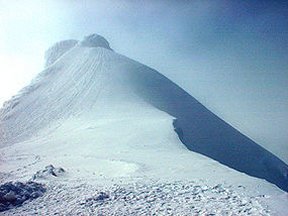
Picture of Snaeffelsjokul Volcano, IcelandIt is clear that Saknussemm DID explore the interior of the Earth and returned, leaving two cryptic clues. The first being a note (his sole surviving known writing and referred to as the Saknussemm Cipher) which had been written in bad Latin, backwards, using the Runic Alphabet (Lidenbrock 1863 & Von Hardwigg 1870). This note was hidden in a book in his possession and remained undiscovered for three-hundred years. The second was a similar note, written in the Latin alphabet in some reddish ink (blood was theorized though blood turns brown when dry) upon the surface of a plum-bob constructed of Icelandic Periodite. This bob was found covered with lava on the slopes of Stromboli Volcano off the coast of Northern Sicily, eventually reaching a curiosity shop in Glasgow where it was purchased by a geology student simply because it was too heavy to be pure lava (Lindenbrock 1880). Both notes are essentially the same, how to enter the bowels of the Earth via the crater of Snaeffellsjokull in Iceland.
Theodore Lytton (1869) and Jonathan Brock (1869) describe the Saknussemm Vortex which is explained as a sort of reverse whirlpool that sucks underground water to fill surface lakes which, with Lindenbrock’s comment on Atlantis, show that the Inquisition missed some of Saknussemm’s works. As the Anderson Expedition (2008) mentions the book Atlantis: The Antediluvian World by Ignatius Donnelly (1882), I would imagine that Anderson may somehow locate the Saknussemm writings on Atlantis as well before leaving for that expedition.
Although the Saknussemm Cipher indicates the central vent of Snaeffels to be revelaed the end of June by the shadow of Skartaris, the Saknussemm Plumb-bob indicates an opening in the side of Snaeffels to be revealed the end of May by that same shadow. It is also clear that the Anderson Journey of 2008 entered by another vent on the outer side of Snaeffels. Thus the Snaeffelsjokul volcano is like a maze with multiple entries to the underworld, some of which may remain undiscovered to this day.
The fact that Arne wrote the Saknussemm Cipher proved that he returned safely to the surface only to meet his fate in the arms of the Inquisition! Another report (Lindenbrock 1880) indicates that he survived the Trial and returned to the Inner World to finally die beneath the surface, though this is based upon the discovery of an unidentified body in a sunken city that Lindenbrock (1880) describes as being ‘Atlantis’, also without proof. When did Saknussemm write his Vortex Theory? After the first trip or did he make numerous visits to study the Interior? Lacking any first-hand copies of his writings, we may never know though I suspect that the man DID make an attempt to visit ‘Atlantis’ which failed, but gave him the tools and information he needed to explore the Interior over multiple trips, giving him the incentive to write his discoveries or the Hollow Earth, of Dinosaur Survivals and the Saknussemm Vortex. It was probably the Dinosaur reports that caused the Inquisiton to burn his works as heretical to Church Teachings.
It is doubtful that Arne made it to Pellucidar but his travels inspired others whose reports were published and from which we can make certain conclusions.
Hastings-Lytton Expeditions
In 1862, an Australian, Casper Hastings, desperate to find his own fortune (he was married to the wealthy Alice Hastings and resented his in-laws commenting how he was a poor man who married for money) entered Taurnaga Crater on White Island (just off the shore of North Island, New Zealand) with two guides in search of gold that was rumored to be found within that crater… and vanished.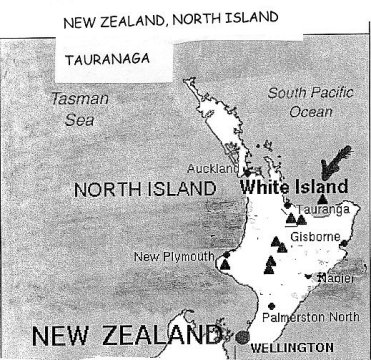
Map of Tauranaga, North Island, New ZealandSeven years later, in 1869, his wife, Alice Hastings, hired the American Geology Professor and adventurer, Theodore Lytton to retrace her husband’s steps and recover the man.
Accompanied by his nephew Jonas and their immigrant Scottish guide McNiff (plus the demanding Alice who had arrived by anther voyage), they entered Tauranaga Crater.
They discover an Inner Sea of fresh within a Mega-Cavern and possesses a low roof, possibly only hundreds of feet high as the ceiling was clearly visable, and an atmospheric glow to simulate sunshine which explains the blue color to all the vegetation. This glow fades every 36 hours to provide a sort of calendar/clock. This Mega-Cavern is found to be the home to light-skinned humans, ape-like humanoids, an intelligent dinosaur (Sauroid) and dinosaurs.
This expedition was reported in the film A Journey to the Center of the Earth (1999) and is referred to as the “Treat Williams film” as that actor played Theodore Lytton. The incident was dated from internal evidence as there was a reference to Darwin publishing his _Origin of the Species ten years earlier in 1859, the Maori Revolt happened between 1860 and 1872 and it takes seven years to declare a man legally dead.
Of note is that the Inner World vegetation was blue, the internal light regularly dimmed but it is clear from the size of the Mega-Cavern, the size of the Tauranaga Opening and the lack of dinosaur sightings on North Island, that the Hastings-Lytton Expedition found a Mega-Cavern that connects with Pellucidar via a Migration Route.
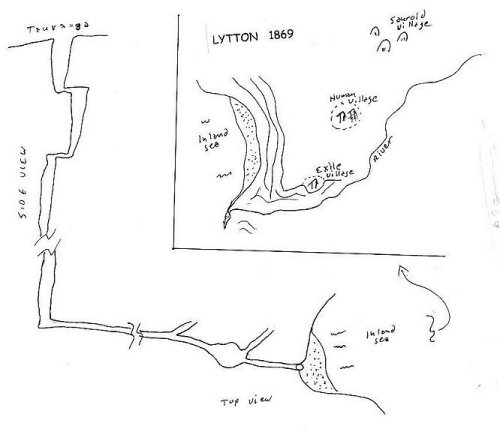
Map of Mega-Cavern explored by Lytton, 1869Lidenbrock Expedition
The 1863 Lidenbrock expedition is probably the most famous of all attempts to reach Pellucidar (referred to as the Center of the Earth) via the cavern system. It is this one that has inspired many others to attempt similar journeys.First made famous by noted historian Jules Verne as A Journey to the Interior of the Earth (1864), Professor Otto Lidenbrock of Hamburg purchased a handwritten book (written in Icelandic Runes) on the Norwegan Princes of Iceland. Purchased on a lark because of the unusual nature of a hardbound book handwritten in a dead language, Lidenbrock found the owners name written inside the cover, Arne Saknussemm. As he was reading the work, a paper fell out (now called the Saknussemm Cipher), also written in Runes that when decoded (it was written in bad Latin backwards then transcribed into Runic letters) gave the following message:
Descend, bold traveler, into the crater of Snaeffellsjokull,
Which the shadow of Scartaris touches before the calends of July,
And you will attain the center of the Earth;
Which I have done.
Arne Saknussemm
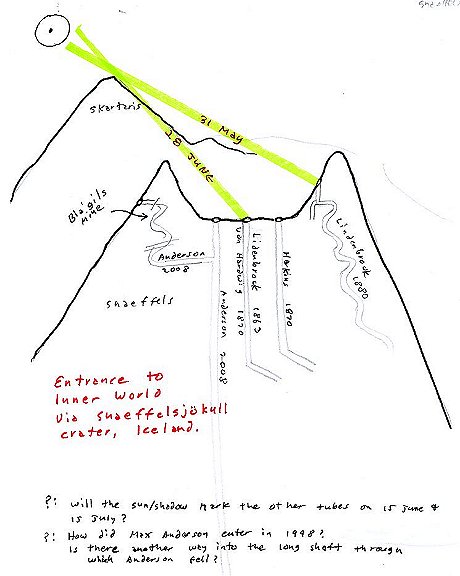
Map of Snaeffelsjokull volcano, IcelandBeing a miser with information and impulsive, Professor Lidenbrock immediately set off for Copenhagen and then to Iceland to follow the directions.
Snaeffels is an extinct volcano some 5000 feet high with an interior cone 2000 feet lower than the peak. It contains three main lava tubes that go essentially straight down and a number of others along the interior walls. A century later, a mine will be carved into the exterior, then abandoned after a dangerous cave-in that killed all but one of the miners. There is also an altar-like stone with Arne Saknussemm carved in Runes.
The sunrise at the end of June gave a shadow to the center tube into which traveled three people: Otto Lidenbrock, his nephew Harry or Henry and their Icelandic guide Hans Beilke (this man will be mentioned again later).
Lacking any notes or guide, the three become lost a number of times until after 43 days, they enter a Mega-Cavern which contains a mushroom forest with 40 foot tall mushrooms and an internal sea (named the Lidenbrock Sea) which is estimated to be 40 miles wide by 1475 miles long with a cavern ceiling 8 miles high and a depth of 85 miles below the surface. Note: later measurements show these to be overly-exaggerated.
Eventually, they exit the Interior via the active volcano, Stromboli just north of Sicily. It is curious that during this entire journey, the trio found but two indicators of Saknussemm, the stone at the entrance and the initials at the exit-tunnel. This may indicate that the central vent may be the wrong one.
This Journey required some 61 days total and produced the following map of the trip:

Map of journey of Lidenbrock (1863) and Von Hardwigg (1870)
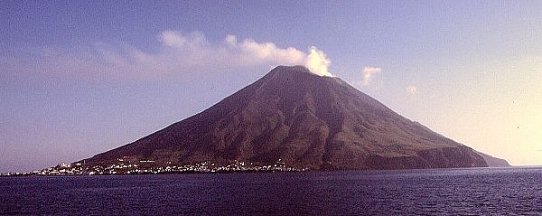
Picture of Stromboli volcano, Italy

Map of Italian volcanosIt is also clear from the descriptions of prehistoric fish-lizards, mammoths and a solitary giant, that they found a Migration Terminus from Pellucidar.
Edward Dennison/Brock
In 1865, Edward Dennison entered a mine in Russian-owned Alaska with his Russian Guide, Mikael, and vanished. Four years later, his wife, Martha, hired Anthropology Professor Jonathan Brock to accompany her to find him for the simple reason that she wanted to know why he left her.
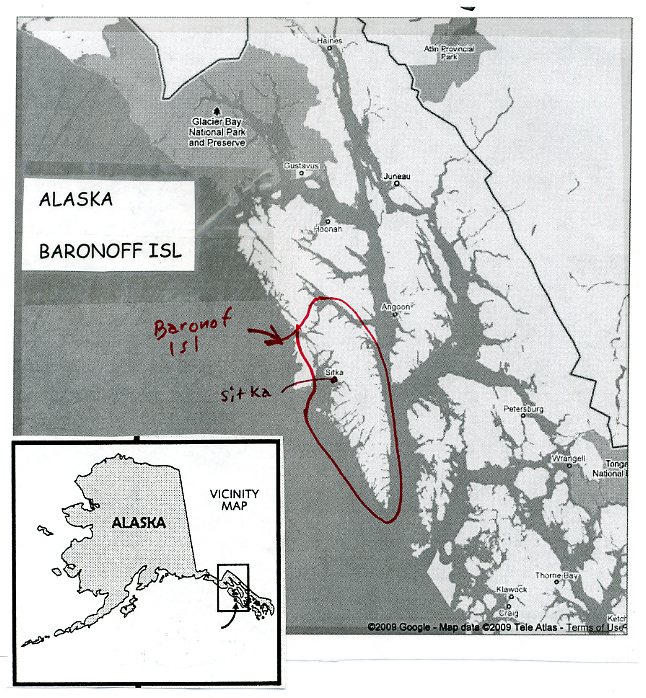
Map of Baronof Island, AlaskaThis mine can only be found as the sun reflects off a certain lake on the Autumn Equinox which makes me wonder how the Russians who carved that mine found it when they went to Sitka for supplies. The pair, accompanied by Jonathan’s nephew, Abel Brock, enter the mine with their Russian Guide, Sergei Petrov, and find a cave that leads into a Mega-Cavern inhabited by dinosaurs and a tribe of Alaskan Indians who consider Edward to be a god because he taught them to hunt dinosaurs from the treetops (previously, the dinosaurs hunted the Indians). After Edward is shown to be mortal, the trio (sans Edward) escape through a small cave back to the surface via a Saknussemm Vortex. This cave was immediately sealed by dynamite.
This Mega-Cavern has no sea but a narrow salty-lake/river inhabited by pliosaurs, green vegetation that resembles a pine forest and American Indians that entered the Mega-cavern centuries ago.
This is dated and located from internal evidence within the filmed version of the expedition, Journey to the Center of the Earth (2008) referred to as the “Rick Schroeder film”. The trio enter the [then] capital of Alaska (Sitka) on Baronof Isle shortly after the purchase of Alaska by America in 1867. From Sitka they traveled overland by horse for ten days so never left Baronof Isle. Thus the Russian mine that leads into the Mega-Cavern is ten hard days horse-ride from Sitka on Baronof Isle.
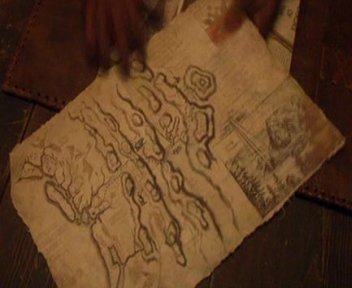
Map of Baronoff Isle per DennisonSince there are no dinosaur survivals on Baronof, it must be presumed that this Mega-Cavern is upon another Migration path from Pellucidar and the caves from this Mega-Cavern to Alaska is too small to allow anything larger than person to traverse.
It is of note that both Martha Dennison and Jonathan Brock are aware of Saknussemm Vortexes. It is also curious how many of these early explorers appear to be related. Lidenbrock, Lindenbrock, Brock? Is there a let’s explore caves’ gene in the Lidenbrock family?
Von Hardwigg
In 1871, Von Hardwigg, an Englishman living in Hamburg, and his nephew Harry [or Henry], recovered the Saknussemm cipher and proceeded along the path of the 1863 Journey. This one, recorded as Journey to the Center of the Earth (1871) also by that noted historian, Jules Verne, is a superficial copy of the 1863 trip. However, a close reading shows that they are two different journeys with Von Hardwigg following Lidenbrock’s trip seven years earlier. Internal evidence indicates that Von Hardwigg’s trip was shorter (only 55 days) and his measurements different from Lidenbrock’s, therefore I presume that Verne recorded the Von Hardwigg Journey and padded it with parts from the earlier trip to increase his word-count and make an otherwise dull journey worth reading.Von Hardwigg enters the Snaeffels Crater with his guide, Hans Beilke who was recommended by the Governor of Iceland. It is clear that the recommendation was made because of Hans’ previous trip and so the Governor felt that were Von Hardwigg to become lost exploring Snaeffels, Hans would be the perfect guide to bring the man back safely.
It is of note that Hans was a quiet man who did not volunteer that he had made this journey before and Von Hardwigg did not ask. Thus Hans was content to follow Von Hardwigg, even when he knew the way better. This includes Von Hardwigg discovering the Hansback! The spring that Hans had carved on his previous journey.
Von Hardwigg estimates the Inner Sea [now renamed the Central Sea] to be 1800 miles long, 40-50 miles wide and 105 miles below the surface with a ceiling miles high (he describes the lowest clouds to be at 6000 feet) and upon setting sail in another raft, they spend 15 days at sea to reach the same beach discovered by Lidenbrock. They enter (or are pulled in) at high tide and exit Stromboli crater.
Concerning the difference in measurements, did Von Hardwigg have better instruments than did Lidenbrock some 8 years earlier? Or were both confused in the turnings underground?
How did Von Hardwigg come into possession of the Saknussemm cipher? Did Lidenbrock’s housekeeper sell the book and cipher in anger with her employer’s vanishing, thus allowing Von Hardwigg to purchase the book? Or did Von Hardwigg read Lidenbrock’s journal and decipher the entrance from the clues presented, leaving Verne to make assumptions?
Here is the Von Hardwigg map based on internal reports:

Surface map showing the journeys of Lidenbrock (1863) and Von Hardwigg (1870)Again, I will present my modified map at the end of this chapter.
Samuel Harkins/Janice Obrien
At the same time Von Hardwigg was planning his Trip, Duchess Janice Obrien was seeking a man to guide her into the Snaeffels Crater in search of her lost husband, Doctor Philip Paul. She found this in Samuel Harkins, a geologist abused by the Royal Academy in London as recorded in Another Journey to the Center of the Earth (2009) by Rick Johnson.Duchess Obrien finances the trip and by her influence, many of the hardships suffered by the previous travelers are avoided though she and her adopted daughter (the Romanian Jewess Ruth) leave Harkins at the underground sea. It is unknown what happens to Harkins after that though it is believed that Obrien and her family continue down to Pellucidar along the Migration Route that leads from Pellucidar to the Central Sea.
It is also clear that although both Lidenbrock and Von Hardwigg enter Snaeffels by the center tube, Harkins and Obrien enter by a different tube, eventually reaching the same locations as did the earlier travelers. It is also noted that they are guided by Runes carved at every junction, some indicating danger. This will be explored further in 1880.
Oliver Lindenbrock
In 1880, newly knighted Scottish Professor Oliver Lindenbrock [related to Lidenbrock?] of Edinburgh is given a piece of Italian lava from the Stromboli Crater off North Sicily. Finding the lava to be too heavy, he removes the lava covering to discover a plumb-bob made of Icelandic periodite. Upon this bob is written, in Icelandic (using the Latin alphabet) in red [presumed blood but unlikely as blood turns brown when dry]:I am dying but my life’s work must not be lost.
Whoever descends into the crater of Snaeffels Yocul can reach the center of the Earth.
I did it.Arne SaknussemmAt sunrise on the last day of May the mountain Scartaris will point the path.Oliver Lindenbrock and a university student, Alexander McKuen notify the Swedish Professor Goteborg of Stockholm of his discovery then learn that Professor Goteborg has left for Iceland before them.
Lindenbrock and Alec rush to Iceland and find Goteborg murdered by Count Saknussemm who seeks to reclaim the inner World discovered by his ancestor. With the help of Professor Goteborg’s widow, Carla, and her dead husband’s gear, they race to enter Snaeffels, guided by a series of three slashes to show the way. Again, Hans accompanies him, this time hired by Lindenbrock who he rescues after being abducted by either Saknussemm or Goetberg. Hans is getting to be an expert at this.
They enter by a different shaft in the inside wall of the crater (not the three shafts described earlier), have different adventures but reach the inner Sea on 1 January, seven months later. Plus they spend only a day on the sea before being shipwrecked on the shore of a lost city they call “Atlantis” where they find a body pointing to a shaft which takes them to the surface via Stromboli crater. The body is presumed to be that of Arne Saknussemm but no evidence is given any more than the city shows a street-sign listing it to be ‘Atlantis’. A lot of suppositions are made here such as the claim that while crossing the now-renamed Saknussemm Sea, they reached the center of the Earth when gold items such as Carla’s gold wedding ring and Hans’ gold tooth are pulled away by an unseen force which Lindenbrock claims to be magnetism. Gold is non-magnetic so this is a false assumption like Atlantis and the body they found.
At the end, in Edinburgh, just before Hans returns to Iceland, he gives a speech in poor English where he states his desire to accompany the professor should he choose to return to the Inner World. As this was his third trip and he is recorded to make one more, the offer is prophetic and indicative of a man who truly enjoys caveing!
This Journey was recorded as Journey to the Center of the Earth (1959) and is referred to as the James Mason film. Note that the shadow that pointed to the central shaft in 1863 and 1871 on the end of June for the Lidenbrock and Von Hardwigg trips is now a month earlier and points to the inner side of the crater for the Lindenbrock journey. Did Saknussemm make more than one trip?
The immediate differences between the 1863/1971 and the 1880 trips are these:
The 1863 & 1871 trips enter through the central shaft on the crater floor but the 1880 journey enters from the inner side of the crater. The 1863 & 1871 journey spend less than two months underground but the 1880 trip spends more than eight months! The 1863 & 1871 trips divide their time between foot ( 40 days average) and sea (16 days average) but the 1880 trip reversed this (255 days on foot and 1 day on the water) The 1863 & 1871 trips never saw any lost city but both describe 12 foot tall humans herding mastodons. The 1880 trip saw only large dimetrodons and a sunken city. In 1863 & 1971, the trip from Rekjavik (a two street dirt-water town) to Snaeffels was a grueling 10 day ride on ponys. By 1880, Rekjavik had become a decent sized town with an excellent hotel and the trip to Snaeffels was now a half-day ride in a comfortable carriage 
Surface map of journey of Lindenbrock (1880)
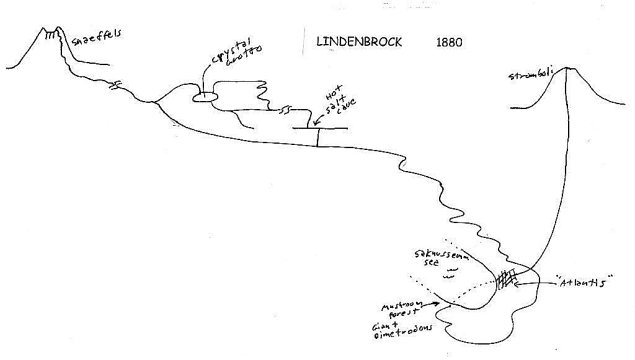
Map of actual journey of Lindenbrock (1880)Lidenbrock II
In 1898, Otto Lidenbrock reentered the Snaeffels volcano accompanied by his nephew Axel and Axel’s fiancée Glauben who insists on coming along. It appears that the two may have been engaged since 1863.Although I have not seen this report, released as Where Time Began (1976), the information indicates that this is Professor Lidenbrock’s second journey. Again, Hans accompanies the Professor.
Eric Carstairs
Sometime before 1979, Eric Carstairs enters a cave east of Cairo, Egypt to find a Mega-Cavern called Zanthodon. Although Mr Carstairs goes no further, it is clear that Zanthodon is on a Migration Route from Pellucidar. These reports were published by the historian Lin Carter under the titles: Journey to the Underground World, Zanthodon, Hurok of the Stone Age, Darya of the Bronze Age and Eric of Zanthodon.
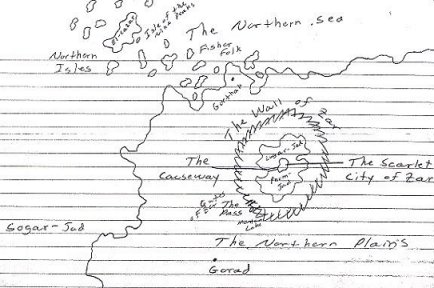
Map of ZanthodonMax Anderson
In July of 1997, Max Anderson, a volcanologist (a geologist who specializes in volcanos), placed a number of sensors around the world to predict future eruptions. He then rushed off to Iceland to check some data and vanished. It was later discovered that he was a Vernian (one who believes that the writings of Jules Verne were true) and his copy of Journey to the Center of the Earth (unknown version) was filled with his notes. This journey was recorded as Journey to the Center of the Earth (2008) and is referred to as the Brendon Frazier film.Ten years later, while babysitting Max’s son, Sean, his brother Travor found the same readings and the pair left for Iceland to confer with a colleague of Max’s. They find the Icelandic scientist dead for some years by natural causes, it is supposed, and they hire the man’s daughter, Hannah, to take them to the sensor on the slope of Snaeffels crater (shown on Trevor’s computer monitor). A lightening storm forces them into a cave that leads to Bla’gills mine which was abandoned in 1947 and they ride an oar car which breaks through to another lava tube that leads into the interior of the Earth once they break through the floor of moscovite.
It is presumed that this is the third shaft because unlike the first two (1883 & 1871), the trio fall for miles and miles before reaching a pool of water far below the surface. This pool leads to a Mega-Cavern where Max’s body is found along with the remains of caveing gear from a hundred years ago. It is unknown who this gear belongs to but the suggested Saknussemm or Lidenbrock are excluded by time and location, the first explored three centuries before the gear had been invented, the latter took a different path.
The shore of this lake suffers periodic rises in temperature to 140-200 degrees that force the trio to build a raft to cross the sea to escape. A day later they reach the further shore to find: giant venus flytraps with advanced nervous system, a T-Rex, giant dandelions, glowing birds and other creatures until they cross a wasteland to a shaft which leads to Mt Vesuvious.
Notes include, their total time underground is less than a week, perhaps a couple days. They enter Iceland but exit Italy even though their initial descent and final ascent are almost directly vertical. There are many unanswered questions here.
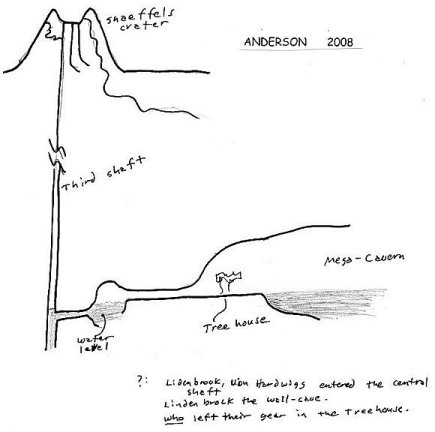
Side view of entry via the third shaft of Snaeffels.
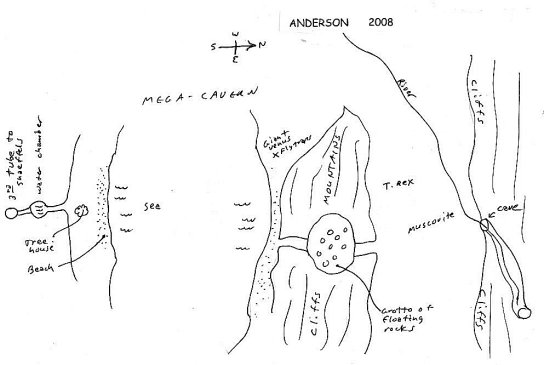
Map of the Mega-Cavern explored by Anderson (2008) |
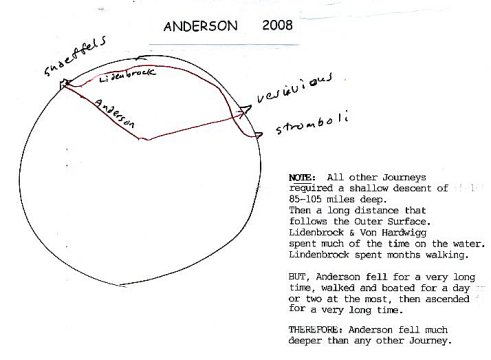
Probable descent of Lidenbrock (1863) and Anderson (2008) showing depths penetrated. Scale is exaggerated for clarity |
It is obvious that no small land or sea area can support the existence of large dinosaurs. The amount of food required of even one large dinosaur is immense forcing constant migrations to new pastures.
ConclusionsThus, the Mega-Caverns discovered by the previous underground explorers and the above ground ‘lost lands’ (Island of the Skull, Maple White Land, Isla Sorna) are simply too small to support the described dinosaurian population.
The conclusion must be that these ‘lost lands’ are simply the terminus of a dinosaur migration form another place, Pellucidar being the only possibility. The mega-Caverns discovered by Saknussemm and others are either Migration Terminus or a resting-place along a migration Route. Had Saknussemm and the others realized this, they would have continued on and eventually reached Pellucidar.
It is also obvious that there are more than one Path into Pellucidar. Tauranaga in New Zealand, Baronof in Alaska, Stromboli (to an extent) in Sicily and Sneaffels in Iceland being the currently known Entry Points.
It is also clear from the various Snaeffels journeys that these entrances interweave and interconnect thus allowing one to enter different openings to meet the true path later on, or to diverge from the true path and rejoin it at a later time. This is called the “Swiss Cheese” theory of the Hollow Earth and the Snaeffels map that includes all trips is shown here.

Side view showing all known entry points from Snaeffels crater, Iceland |

Surface map of Interior journeys, corrected by the author |
There are two main methods to enter Pellucidar other than the Polar Openings and the Cavern System. Matter Transmitter and Mechanical Mole. 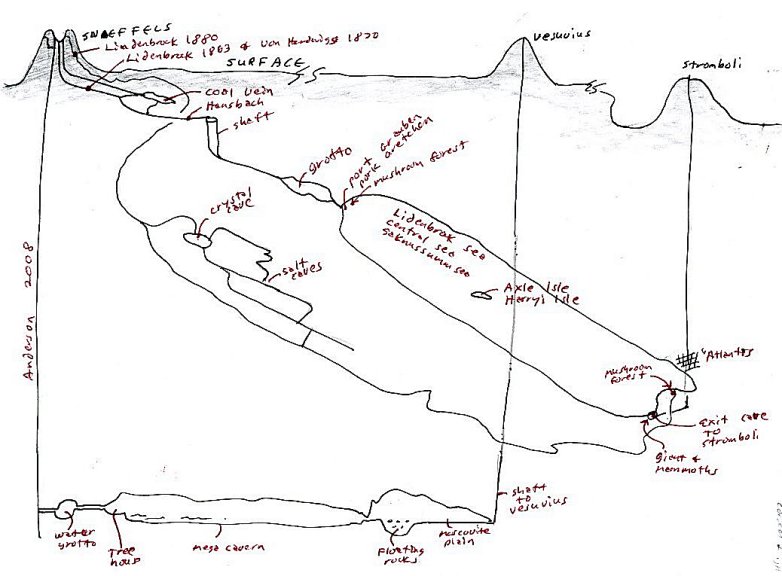
Underground map showing the main journeys between Snaeffels Crater, Iceland and Italy.
MISC METHODSAbner Perry was the first to enter Pellucidar via Mechanical Mole in 1904. This was a disaster as his intention was to simply create a method of mining raw ore cheaply and easily. Unfortunatly, the mechanical Mole failed to turn and days later, accompanied by American financer David Innes, exited in Pellucidar. This was chronicled by that famous historian Edgar Rice Burroughs in his classic work At the Earth's Core (1914).
In 1984, James Blaylock described a dual attempt to reach Pellucidar in his The Digging Leviathan (1984). One attempt was by diving bell (an obvious impossibility) and the other by mechanical Mole. Not having read this report, I cannot speak further other than one of these is said to have succeeded and I suspect it was the Mole as the magma layer would preclude any other attempt. The Lytton and Anderson journeys were so close to the surface that they never approached the intermediate magma layer described by Perry.
In 2008, Joseph Harnet used a Mechanical Mole to enter Pellucidar in an attempt to rescue a group of US Army soldiers trapped within by a malfunctioning matter Transmitter. I will go into more detail later on under the next section.
Matter Transmitters are a more modern method of entering Pellucidar, most of which were done by accident.
Christopher West
Sometime before 1976, Christopher West invented the first Matter Transmitter as chronicled by John Eric Holmes in the report Mahars of Pellucidar (1976). In this report, Mr West invents a Matter transmitter, discovers that the Earth is hollow and sees a woman in danger. Grasping a red fire axe, he transports himself to Pellucidar to rescue the woman. He manages to communicate with his former lab but it is uncertain if he ever returned to the surface.Maureen Birnbaum
Ms Birnbaum is an unusual person. Possessing the ability to teleport herself throughout space (in a manner similar to that learned by John Carter), she manages to get lost often and in 1985 appeared in Pellucidar where the Sagoths claimed her as a goddess. She eventually manages to escape by teleporting out of Pellucidar as chronicled by her biographer, George Effinger in Maureen Birnbaum at the Earth’s Core (1986)Estrith Mormor
Estrith Mormor is an elderly Bronze Age Dane who was rescued from death by freezing by the alien Vartanians who are interstellar Mercenaries. In return for her service, they returned her to her youth, trained her and transported her across time as a Special Agent.In 2008(?), she was transported by a Vartanian Matter Transmitter (SRP) into Pellucidar to retrieve another stolen alien SRP. Her comments imply that she had been to Pellucidar before. Her report was published by Rick Johnson as Pellucidar? I hate Pellucidar! (2008).
Kristen Redford
The final attempt to enter Pellucidar was in 2008 when Emily Radford invents a Matter Transmitter and a Mechanical Mole. As this was a private laboratory under contract to the US Government, I suspect that Ms Radford simply refined and improved Mr West’s 1976 device.This Matter Transmitter was used to teleport a team of six female soldiers from California to Germany to repair a satellite. As the Transmitter was a line-of-sight device, the beam penetrated the Earth’s Crust and deposited them on the surface of Pellucidar beneath Wyoming. Two of the team were killed by a T-Rex and another by giant spiders until Joseph Harnett, ex-husband of Emily Redford, accompanied by Emily, used her Mechanical (laser) Mole to enter Pellucidar and rescue the remaining members of the team.
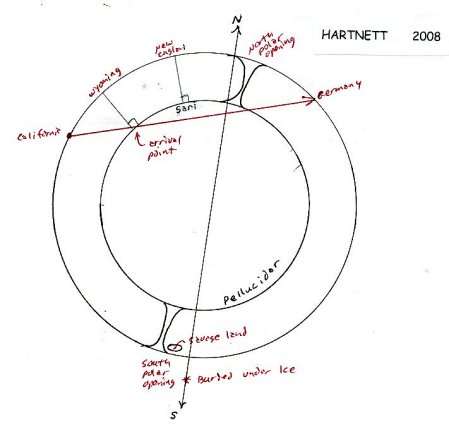
Map showing path of the Matter Transmitter and suspected arrival point in {ellucidar.Although the report Journey to the Center of the Earth (2008) [referred to as the Greg Evigan film] insists that the team entered a bubble 600 km down, it is clear that they actually entered Pellucidar which is 500 miles (600 km) down. The existence of the T-Rex and other dinosaurs show that the ‘bubble’ could not be large enough to contain such creatures described and the described distance down indicates the surface of Pellucidar and not a Mega-Cavern.
The volcano through which the Mole eventually traveled and exited was a part of the Yellowstone Super-volcano which locates that part of Pellucidar (infested by giant spiders) they explored.
FINAL WORDS
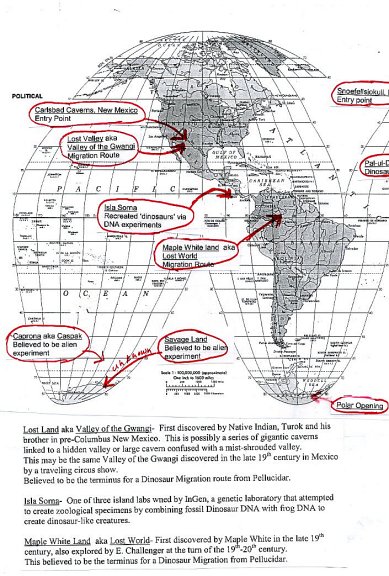
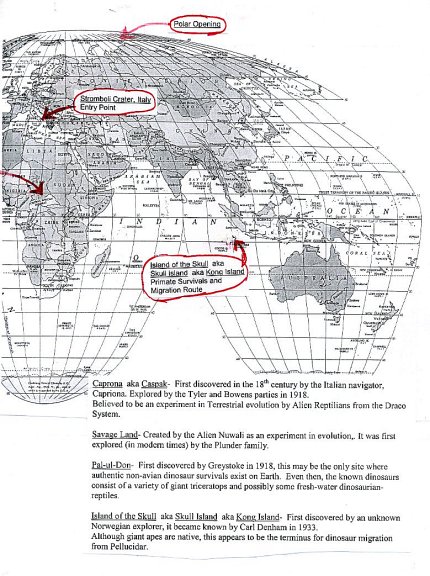
It is clear from a close examination of the many attempts to visit the Inner World, that there are a number of paths to Pellucidar.It is equally clear that unless we possess a modern laboratory that is capable of building a mechanical Mole or a Matter transmitter, our options for entry are limited to but two: The North Polar Opening and a very long hike through any of the Migration Terminus or Entry points that are scattered around the globe. Each of which, thanks to the observations of Den Valdron, are near but not ON a tectonic plate. One would imagine that these Migration Routes pass through the Magma Layer described by Abner Perry via a cold spot that solidifies the magma at that point to prevent cooking the traveler.
If the cave system is to be used, it is suggested that multiple trips be made, each trip planting caches of food and water so that the succeeding trip may penetrate deeper until a Mega-Cavern is located. From that point, the trip into Pellucidar should be a simple one to follow as the dinosaurs that use these Routes must feed often and so food and water should be abundant.
Personally, I would suggest a dirigible or very long range ship through the North Polar Opening followed by a small dirigible or helicopter after the ship beaches in Pellucidar. This would reduce the hiking time from months to days, those days being comfortable and lacking in danger. Though to be honest, it seems to be the danger that attracts the traditional beautiful princess who then falls in love with the traveler.
Good Luck!
Cavern System- The vast interconnected system of caves and tunnels that leads from one point to another point. For purposes of this paper, it refers to any system of interconnected caves, tunnels and volcanic fissures that connects the Surface of the Earth to Pellucidar.
VOCABULARYDinosaur Survival- A Cryptid. Any dinosaur sighted on the surface of the Earth. They are assumed to be either a dinosaur that has managed to survive 65million years or more or to be a part of a very small and isolated breeding population that has remained undiscovered. Both are impossible. Dinosaur survivals are a dinosaur from Pellucidar that got lost on a Migration route and wandered into civilized view for a short time before dying or returning to the Migration path.
Entry Point- A cave or fissure, often within a volcano, that leads to a Mega-Cavern inhabited by dinosaurs. These Mega-Caverns lead to Pellucidar.
Inner Surface- The surface of Pellucidar that exists within the hollow sphere of Earth.
Lost land- An isolated area where extinct species appear to survive. The most famous being Maple White Land in Brazil, Island of the Skull off Sumatra and (thanks to Den Valdron’s work) Isla Sorna off Costa Rica. Other Lost Lands include the Galapagos and the Mekong Valley in Vietnam.
Mega-Cavern- A large, giant cavern in which a mini-eco-system has formed. One such Mega-Cavern lies under Europe from Scotland to Sicily and contains a huge underground sea. Mega-Caverns are often inhabited by dinosaurs from Pellucidar and people from both Pellucidar and Earth. Evolution continues within Pellucidar and these Mega-Caverns thus creating new forms of ancient species.
Migration Route- Large plant eating animals must migrate or risk eating all local food. Most of these animals establish regular journeys between their feeding grounds, allowing the previously decimated pastures to recover. In this paper, a Migration route refers to that path established by dinosaurs between Pellucidar and the Surface World.
Migration Terminus- The end of a Migration Route. On the Surface, these include Maple White Land in Brazil, Isla Sorna in Costa Rica, Island of the Skull off Sumatra. Den Valdron notes that these Migration Termini are along Continental Fault lines, and so are volcanically active which leads to their formation.
Outer Surface- The surface of the Earth on the exterior of the planet. We live here.
Polar Opening- At either Pole, the Earth opens up to create a ‘hole’ that connects the Surface with Pellucidar. Although presumed to be 500 miles in diameter and at the Geographic Poles, they are much smaller and offset from the pole by some likes.
The North Polar opening is at 84 N by 141 E.
The South Polar opening is at 84 S by 38 W.Swiss Cheese Theory- that theory as postulated by the author to describe the Cavern System which makes up certain parts of the Earth’s crust.
ARTICLES
CITED WORKS
How Bad do You want to go to Pellucidar by David Critchfield
King Kong I: The Lost Civilization of Skull Island by Den Valdron
Where is the Opening to Pellucidar by Rick JohnsonCINEMA
Journey to the Center of the Earth- 1959 starring James Mason
Journey to the center of the Earth- 1999 starring Treat Williams
Journey to the Center of the Earth- 2008 starring Brandon Frazier
Journey to the Center of the Earth- 2008 starring Greg Evigan
Journey to the Center of the Earth- 2008 starring Rick Schroeder
King Kong- 1933 starring Faye Wray
Valley of the Gwangi- 1969 starring James Franciscus
Where Time Began- 1976 starring Kenneth MooreNOVELS
At the Earth’s Core- 1914 by Edgar Rice Burroughs
Darya of the Bronze Age- 1981 by Lin Carter
Eric of Zanthodon- 1982 by Lin Carter
Hurok of the Stone Age- by Lin Carter
The Land that Time Forgot- 1918 by Edgar Rice Burroughs
A Journey to the Center of the Earth- 1971 by Jules Verne
A Journey to the Interior of the Earth- 1864 by Jules Verne
Journey to the Underground World- by Lin Carter
The Lost World- 1912 by Arthur Conan Doyle
The Lost World- 1995 by Michael Crichton
Mahars of Pellucidar- 1976 by John Eric Holmes
Maureen Birnbaum at the Earth’s Core- 1986 by George Effinger
Tarzan at the Earth’s Core- 1930 by Edgar Rice Burroughs
Tarzan the Terrible- 1918 by Edgar Rice Burroughs
Zanthodon- 1980 by Lin CarterFAN-FICTION
Another Journey to the Center of the Earth- 2009 by Rick Johnson
Back to the Earth’s Core- 1971 by William Gilmour
The Digging Leviathan- 1984 by James Blaylock
Moon Maid at the Earth’s Core- 2001 by Andy Nunez
Pellucidar? I Hate Pellucidar!- 2008 by Rick Johnson
Pellucidar Revisited- 1997 by Sean Edward (Tony) Phillips
Rescue from Pellucidar-2009 by Rick Johnson
The Sun Inside-2009 by David Schwartz
The Vikings in Pellucidar- 1932 by 1932BIOGRAPHY
The Smoky God- 1908 by Olaf JansenREFERENCE
Atlantis: the Antediluvian Word- 1882 by Ignatius Donnelly
Origin of the Species-1859 by Charles DarwinWEBSITES
www.npiee.org
www.geocities.com/RikJohnson_erb
www.edgarriceburroughs.ca
www.pellucidar.org
www.ERBzine.comWEB FEATURES IN ERBzine
ERBzine 2296: Where is the Opening to Pellucidar
ERBzine 1520: King Kong I: The Lost Civilization of Skull Island
Den Valdron Features in ERBzine
King Kong I: The Lost Civilization of Skull Island by Den Valdron
Where is the Opening to Pellucidar by Rick Johnson
At the Earth's Core - eTezt by ERB
Pellucidar - eText by ERB
Tarzan at the Earth's Core - eText by ERB
Tarzan the Terrible - eText by ERB
The Land that Time Forgot- eText by Edgar Rice Burroughs
ERBzine 2347: How Bad Do You Want to Go to Pellucidar?
Jahlanna of Pellucidar by Sean Edward Phillips
Rescue from Pellucidar
The Vikings in Pellucidar
Visit the Pellucidar Film Galleries
GALLERY I | GALLERY IIRick Johnson Feature Articles and Fiction in ERBzine
NAVIGATION GUIDE
